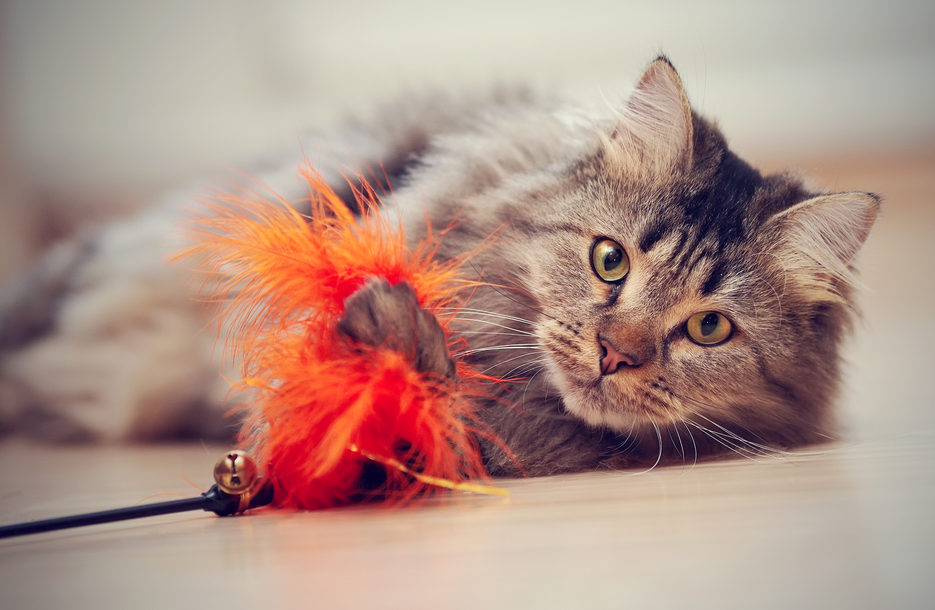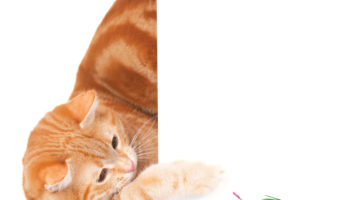Regular play helps keep your cat fit, but because felines prefer toys that move, you need to make her playtime interactive.
If you’re like most cat owners, your kitty has a sizable collection of toys that you’ve bought or made for her over the years. You’ve probably also noticed that she doesn’t play with most of them. This is because toys on their own are not enough — cats need interactive play that includes your participation.
“While you may have lots of toys around the house for your cat, the problem is that they’re essentially ‘dead’ prey,” writes cat behavior expert Pam Johnson-Bennet in her article “Interactive Play Therapy for Cats” (catbehaviorassociates.com). They don’t move…[unless] your cat bats at them. With the interactive toy, however, she doesn’t have to be both predator and prey – she can simply focus on being the hunter.”
Interactive play isn’t just for fun – it’s also important to your cat’s health. Without regular play, indoor cats in particular don’t get enough exercise, and that can lead to boredom and obesity.
Here are four steps to successful interactive play times with your cat.
1. Make toys move like prey animals
In the wild, prey animals move away from predators, not towards them. This is why, if you throw a ball or catnip mouse toward your cat, the response will likely be indifference (or possibly fear caused by the object’s sudden approach). But if you throw the toy away from her — especially if you rattle it first or flick your wrist to indicate where you will throw it – you are much more likely to be rewarded with an eager chase.
2. Learn your cat’s style
Cats have individual preferences when it comes to play, just as cats in the wild vary in their choice of prey. Experiment with different methods of play, especially if your cat is not showing much interest in the game. If you are playing with a string, for example, try waving and wiggling it around your cat, pulling it in straight lines away from her, jerking it into the air, and/or hiding it momentarily behind furniture. This will help you learn which technique appeals most to her individual prey preferences, and maximize her interest in playtime.

3. Play fair
If your cat lies down during playtime, she is signaling that it’s time for a break. In the wild, cats hunt in short bursts; playtime that extends too long can tire your cat out.
If you have more than one cat, be sure to give them equal play time, preferably separated from each other, but at least with attention to fairness. For example, if you’re waving a string, let one cat go at it for a while, and then the other, and so on. In multi-cat households, equal access to resources is essential to keeping your cats at peace with each other.
Also, remember to protect your own boundaries — don’t allow your cat to play with your hand as if it’s a toy, biting and gripping your skin. Always use an actual toy instead, to protect your skin and discourage hand-biting. If your cat or kitten does grip your hand in play, free it not by pulling it away, which only stimulates her more, but by pushing it towards her, which will cause her to pull away instead.
4. End with a reward
Don’t let your cat’s chase go unfulfilled – let her catch the toy when you’re winding up playtime. And if you treat or feed her afterward, you’ll have provided her with the full hunting experience!
When playtime is over, hide some of your cat’s toys away; otherwise she may lose interest in them. Providing variety through toy rotation also helps. And make sure to put away strings and other toys that are small enough for your cat to swallow.
Don’t let your cat’s chase go unfulfilled – let her catch the toy when you’re winding up playtime.
Get creative with your cat’s toys
There are all kinds of great cat toys on the market, from traditional catnip mice to feather toys, wands and more. You can also make your own cat toys from simple items around the house.
- Balled-up paper – crinkly paper balls are always a hit.
- Flashlight or laser pointer – wave the beam around for your cat to try and catch, but be sure not to shine it into his eyes, especially if you’re using a laser pointer.
- Small paper bag or empty paper towel tube — put a treat or toy inside for your cat to try and paw out.
- Large paper (not plastic!) bag or cardboard box – cats love to play inside bags and boxes.
- A sheet of newspaper – spread it out on the floor and put a toy under it for your cat to paw out, or prop up a corner of the paper so she can get under it.
- Sock or washcloth – wiggle it about for your cat to wrestle with.
Daily interactive play times, even if they last just a few minutes at a time, will result in a healthier, happier cat.







No Comment